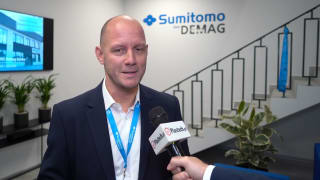Automotive series production for organomelt
organomelt - the name given to a fully automatable method of processing continuous fibre-reinforced semi-finished thermoplastic composites, or organic sheets - will be on the threshold of automotive series production at Chinaplas 2018. In 2017, ENGEL supplied integrated manufacturing cells to two reputable tier suppliers. For automobile manufacturers, thermoplastic matrix materials are the main attraction of the technology. On the one hand, the thermoplastic approach enables functional bonding of the carrier structure in the injection mould in a single work step; on the other, it simplifies the development of recycling concepts so that components are returned to the material cycle at the end of their lifespan.Fibre composite components produced with organomelt can replace steel, even in safety-critical areas; one example would be for brake pedals. At Chinaplas, ENGEL will use tablet housings to show how very high stability can be achieved, even with extreme thin-wall technology. Working as development partners, ENGEL, Bond-Laminates (Brilon, Germany) and Leonhard Kurz (Fürth, Germany) have succeeded in producing wall thicknesses of just 0.6 mm, thereby combining extreme thin-wall technology with maximum production efficiency. To reform, overmould and decorate thermoplastic fabrics to a high standard in a single work step, the manufacturing cell combines the organomelt process with IMD (in-mould decoration). Compared to the conventional multi-stage production of decorated housing components, the integrated organomelt process removes the need for several work steps. This reduces time needed and production costs as well as the carbon footprint. The manufacturing cell comprises an ENGEL insert injection moulding machine in a vertical design with a roll-to-roll IMD unit, an ENGEL easix articulated robot and an infrared oven also developed and produced by ENGEL.
The whole process is very easily and clearly controlled via the CC300 control panel of the injection moulding machine. Another advantage of the integrated solution is the fact that the injection moulding machine, robot and infrared oven automatically coordinate their workflows, thereby enhancing overall efficiency.
In-situ polymerisation combines reactive processing and injection moulding
ENGEL is also a pioneer in the field of reactive processing when it comes to increasing the use of thermoplastic matrix materials. In a video, ENGEL will present a pre-series manufacturing cell that combines the in-situ polymerisation of ε-Caprolactam (T-RTM) with subsequent functionalisation of the carrier structure in the injection mould on an ENGEL v-duo machine. To represent the wide range of possible applications, ENGEL has created a cell for the production of shovels with partners that include Schöfer of Schwertberg, Austria.The v-duo clamping unit is equipped with a sliding table fitted with two mould halves. Dry, pre-shaped reinforcing fabrics are inserted into the first cavity and infiltrated with the reactive matrix. Solid ε-Caprolactam is melted to do so, and thanks to its low viscosity, the dry fibres can be wetted particularly well. A highly resilient composite is thus formed when polymerising to polyamide 6. Since reactive processing takes place below the polymer’s melting temperature, the composite prepreg can be transferred to the second cavity immediately after being produced in order to inject reinforcing ribs and contours of short glass fibre-reinforced PA 6. Polymerisation and injection moulding take place simultaneously, with an ENGEL viper double robot transferring the semi-finished composites and handling the fibre preforms and finished parts.

The in-situ polymerisation of ε-Caprolactam opens up new possibilities for producing fibre-reinforced plastic parts with a thermoplastic matrix.



